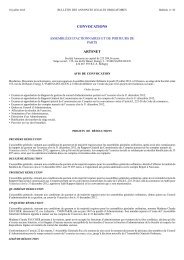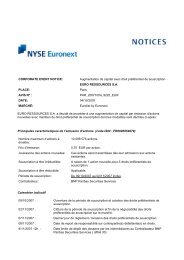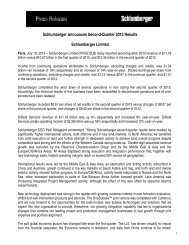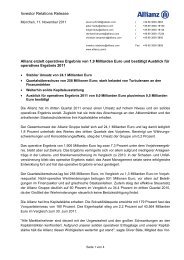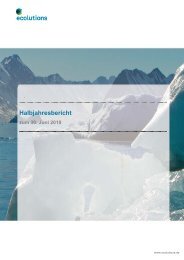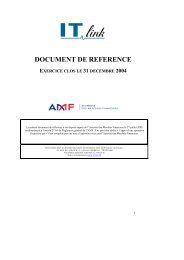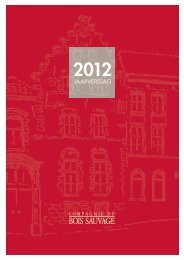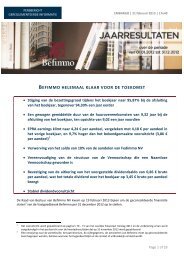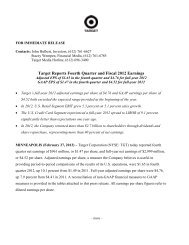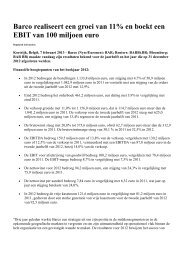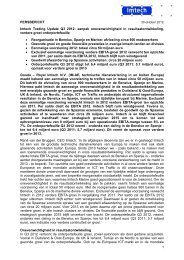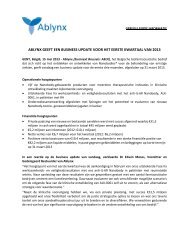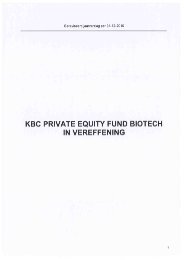FORM 10-Q
FORM 10-Q
FORM 10-Q
Create successful ePaper yourself
Turn your PDF publications into a flip-book with our unique Google optimized e-Paper software.
other markets. The group reported a decline in unit case volume of 2 percent in the Central and Southern Europe business unit and a volume decline of 3<br />
percent in the Iberia business unit.<br />
In Latin America, unit case volume increased 4 percent, which consisted of 2 percent growth in sparkling beverages and 11 percent growth in still beverages.<br />
The growth reported throughout Latin America was driven by strong activation of brand and category advertising as well as investments in cold-drink<br />
equipment and continued segmentation across multiple price points and package sizes. The group's growth in sparkling beverages was led by 2 percent growth<br />
in brand Coca-Cola and 5 percent growth in both Trademark Fanta and Trademark Sprite. Still beverage growth in Latin America reflected 53 percent growth<br />
in ready-to-drink teas, 19 percent growth in sports drinks, 8 percent growth in packaged water and 6 percent growth in juices and juice drinks. The group's<br />
growth in ready-to-drink teas was primarily a result of the strong performance of Fuze Tea, which was launched after the first quarter of 2012. Brazil reported<br />
unit case volume growth of 3 percent, which consisted of 2 percent growth in brand Coca-Cola, 8 percent growth in Trademark Fanta and 6 percent growth in<br />
still beverages. Latin America also benefited from unit case volume growth of 3 percent in Mexico and 2 percent growth in Argentina.<br />
Unit case volume in North America increased 1 percent, led by 6 percent growth in still beverages. Still beverage growth in North America was led by 23<br />
percent growth in ready-to-drink teas, including Gold Peak, Honest Tea and Fuze. Still beverage growth in North America also reflected 3 percent growth in<br />
juices and juice drinks as well as 5 percent growth in packaged water, partially offset by a slight decline in sports drinks reflecting the impact of aggressive<br />
competitive pricing. Growth in juices and juice drinks included 9 percent growth in Trademark Simply which was driven by new flavors and growth in<br />
single-serve packaging. The group's unit case volume in sparkling beverages declined 1 percent, but included slight growth in brand Coca-Cola and 3 percent<br />
growth in Coca-Cola Zero, reflecting the group's strong marketing campaign around NCAA March Madness.<br />
In Pacific, unit case volume increased 3 percent, which consisted of 6 percent growth in sparkling beverages and a 1 percent decline in still beverages. India<br />
reported 8 percent unit case volume growth, led by growth of 30 percent in brand Coca-Cola, 13 percent growth in Trademark Sprite and 8 percent growth in<br />
Trademark Thums Up. India's growth in sparkling beverages reflected the impact of strong integrated marketing campaigns and continued expansion of<br />
packaging choices to consumers. Japan's unit case volume increased 1 percent, which included 4 percent growth in sparkling beverages, partially offset by a<br />
decline of 1 percent in still beverages. China reported unit case volume growth of 1 percent, despite the impact of the economic slowdown and poor weather.<br />
China's growth included 8 percent growth in sparkling beverages and 14 percent growth in juices and juice drinks. Still beverages in China declined 9<br />
percent, reflecting a decline in packaged water volume as we focused on driving more profitable growth in packaged water through immediate consumption.<br />
The group's volume results also benefited from 18 percent growth in Thailand and 12 percent growth in South Korea.<br />
Unit case volume for Bottling Investments decreased 6 percent. This decrease primarily reflects the sale of a majority ownership interest in our previously<br />
consolidated bottling operations in the Philippines to Coca-Cola FEMSA, S.A.B. de C.V. ("Coca-Cola FEMSA") in January 2013. The unfavorable impact of<br />
this transaction on the group's unit case volume growth was partially offset by growth in other key markets where we own or otherwise consolidate bottling<br />
operations, including unit case volume growth of 1 percent in China, 8 percent in India and 3 percent in Germany. The Company's consolidated bottling<br />
operations accounted for 36 percent, 69 percent and <strong>10</strong>0 percent of the unit case volume in China, India and Germany, respectively.<br />
Concentrate Sales Volume<br />
During the three months ended March 29, 2013, unit case volume grew 4 percent and concentrate sales volume grew 2 percent compared to the three months<br />
ended March 30, 2012. The difference between the consolidated unit case volume and concentrate sales volume growth rates during the three months ended<br />
March 29, 2013, was primarily due to having two fewer selling days during the first quarter of 2013 when compared to the first quarter of 2012. In addition,<br />
this difference reflects the timing of concentrate shipments and the impact of unit case volume from certain joint ventures in which the Company has an equity<br />
interest, but to which the Company does not sell concentrates, syrups, beverage bases or powders. Concentrate sales volume growth is calculated based on the<br />
actual amount of concentrate sold during the reporting period, which is impacted by the number of selling days. Conversely, unit case volume growth is<br />
calculated based on average daily sales, which is not impacted by the number of selling days in a reporting period.<br />
30



